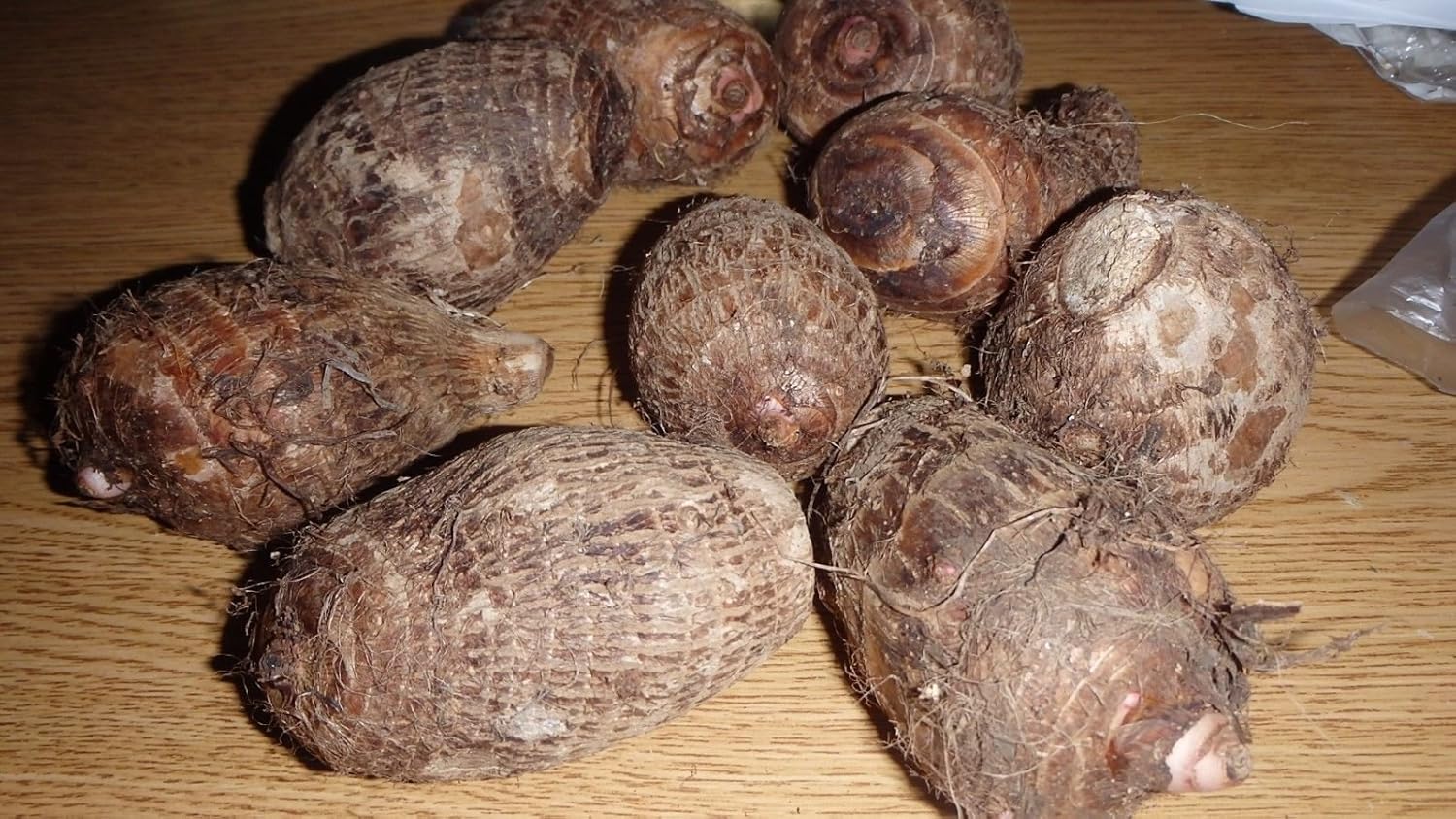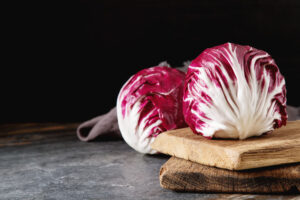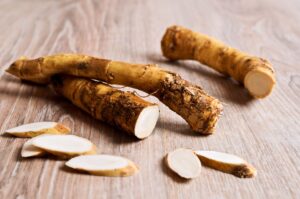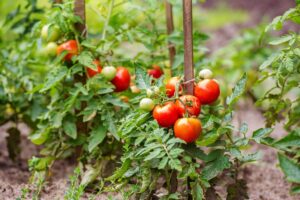How to Grow and Use Culinary Eddoe: A Complete Guide
Are you looking to grow your own tropical root vegetables at home? Eddoe (Colocasia esculenta var. antiquorum), a smaller variety of taro, offers a starchy, nutty flavor that can enhance numerous dishes. This versatile crop is gaining popularity in the US market as more home gardeners discover its unique taste and impressive nutritional profile. Whether you have a spacious garden, a small balcony with pots, or just a sunny windowsill, you can successfully grow this tropical tuber at home.
What is Eddoe?
Eddoe, sometimes called “eddo” or “Japanese taro,” is a starchy root vegetable belonging to the Araceae family. While similar to its larger cousin taro, eddoe tubers are smaller, about the size of small potatoes, with a hairy brown exterior and cream-colored flesh with purple specks. According to the United States Department of Agriculture (USDA), eddoe is rich in fiber, vitamins, and minerals, making it both a culinary delight and a nutritious addition to your diet.
The Growing Popularity of Eddoe in the US Market
Though traditionally popular in Caribbean, Asian, and African cuisines, eddoe has been steadily gaining traction in US markets. Health-conscious consumers are drawn to its:
- Lower glycemic index compared to potatoes
- Rich fiber content
- Good source of potassium and vitamin E
- Versatility in various cuisine styles
As more Americans explore international cooking at home, the demand for eddoe has increased, creating an opportunity for home gardeners to grow this specialty crop.
How to Grow Eddoe Outdoors in Your Garden
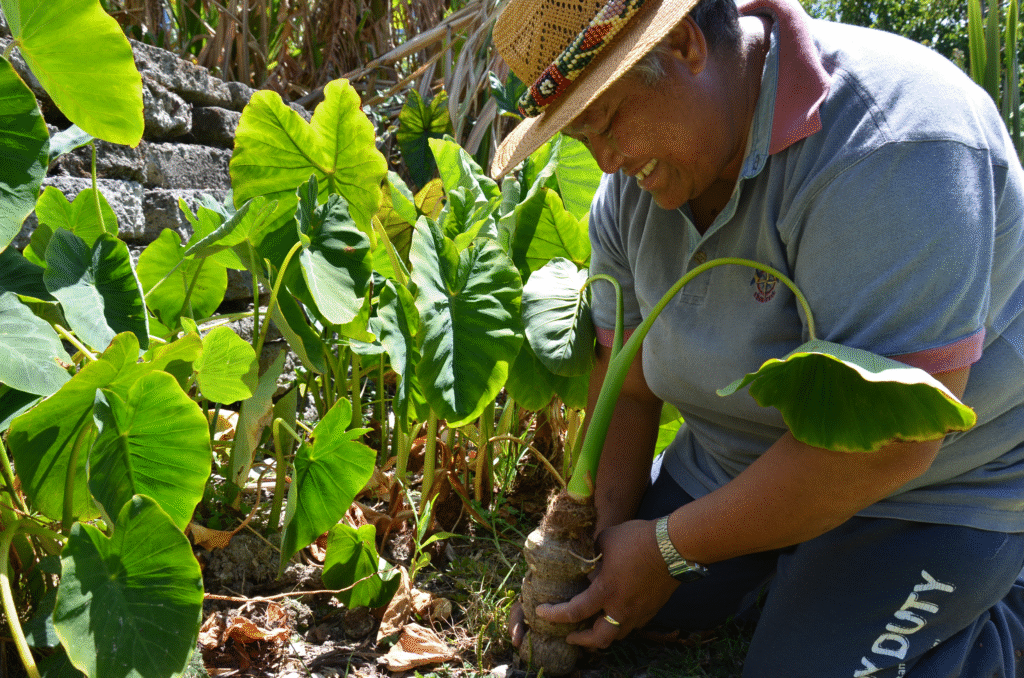
Climate and Growing Conditions
Eddoe thrives in warm, humid conditions similar to its tropical origins. For successful outdoor cultivation:
- USDA Hardiness Zones: Best suited for zones 8-11
- Temperature: Requires temperatures between 70-85°F (21-29°C)
- Growing Season: Needs a long, warm growing season (at least 200 days)
- Sun Requirements: Partial shade to full sun, depending on your climate
- Soil Type: Rich, moist, well-draining soil with plenty of organic matter
Planting Process
To grow eddoe outdoors in your garden:
- Prepare the soil: Till the soil to a depth of 12 inches, incorporating compost or well-rotted manure.
- Timing: Plant in early spring after all danger of frost has passed.
- Preparing the tubers: Select healthy, firm eddoe corms with visible eyes or buds.
- Planting depth: Plant tubers 2-3 inches deep with eyes facing upward.
- Spacing: Space plants 12-18 inches apart in rows 2-3 feet apart.
- Mulching: Apply a 2-3 inch layer of mulch to conserve moisture and suppress weeds.
Ongoing Care
For optimal growth, your eddoe plants require:
- Watering: Keep soil consistently moist but not waterlogged. Eddoe loves humidity but not soggy conditions.
- Fertilization: Apply a balanced fertilizer every 4-6 weeks during the growing season.
- Weeding: Remove competing weeds regularly.
- Hilling: As plants grow, hill soil around the stems to protect developing tubers.
Growing Eddoe in Containers
Limited space? No problem! Eddoe grows well in containers, making it accessible for patio gardeners.
Container Selection
- Choose containers at least 18 inches deep and 18-24 inches wide.
- Ensure containers have adequate drainage holes.
- Plastic or fabric grow bags work well, as do large ceramic pots.
Potting Medium
Create the ideal growing environment with:
- 60% good quality potting soil
- 20% compost
- 20% perlite or coarse sand for drainage
Container Growing Process
- Fill your container with the potting medium to about 2 inches below the rim.
- Plant one eddoe tuber per 5-gallon container (or 2-3 in larger containers).
- Place tubers 2-3 inches deep with eyes facing up.
- Water thoroughly after planting until water runs from drainage holes.
- Position containers in a location receiving 4-6 hours of sunlight.
Container Care Tips
- Watering: Container-grown eddoe dries out faster than garden plantings; check soil moisture daily.
- Fertilization: Apply liquid fertilizer every 2-3 weeks at half strength.
- Protection: Move containers to sheltered locations during extreme weather.
Growing Eddoe Indoors
Yes, you can grow eddoe indoors with the right conditions! This is especially helpful for those in colder climates.
Indoor Growing Requirements
- Light: Place near a south-facing window or provide 8-10 hours of grow light.
- Temperature: Maintain room temperatures between 70-80°F (21-27°C).
- Humidity: Increase humidity with pebble trays or a small humidifier.
- Container: Use deep containers (at least 12 inches) with excellent drainage.
Indoor Growing Process
- Fill a deep container with potting mix similar to that used for outdoor containers.
- Plant one tuber per container, eyes up, 2 inches deep.
- Water thoroughly but allow the top inch of soil to dry slightly between waterings.
- Place in your brightest window or under grow lights.
- Rotate the container weekly to ensure even growth.
Common Indoor Growing Challenges
- Insufficient light: Supplemental grow lights may be necessary, especially in winter.
- Low humidity: Regular misting or a humidity tray helps simulate tropical conditions.
- Pests: Check regularly for spider mites and aphids, which can be problematic for indoor plants.
Growing Eddoe from Seeds vs. Tubers
Most gardeners grow eddoe from tubers (corms), which is easier and faster. However, growing from seeds is possible, though less common and more challenging.
Starting from Tubers
- Pros: Faster harvest, more reliable germination, easier process
- Cons: May be harder to find quality tubers, potential for disease transmission
Process:
- Select firm, unblemished tubers with visible eyes/buds.
- You can pre-sprout tubers by placing them in a warm, humid environment for 1-2 weeks before planting.
- Plant as directed in previous sections.
Starting from Seeds
- Pros: Disease-free start, genetic diversity
- Cons: Very long maturation period, inconsistent results, difficult to find true seeds
Process:
- Soak seeds for 24 hours before planting.
- Plant seeds ¼ inch deep in seed-starting mix.
- Keep consistently moist and warm (75-80°F/24-27°C).
- Expect germination in 2-3 weeks.
- Transplant seedlings when they have 2-3 true leaves.
- Be prepared for a much longer growing season when starting from seed.
Eddoe Growing Timeline and Harvest
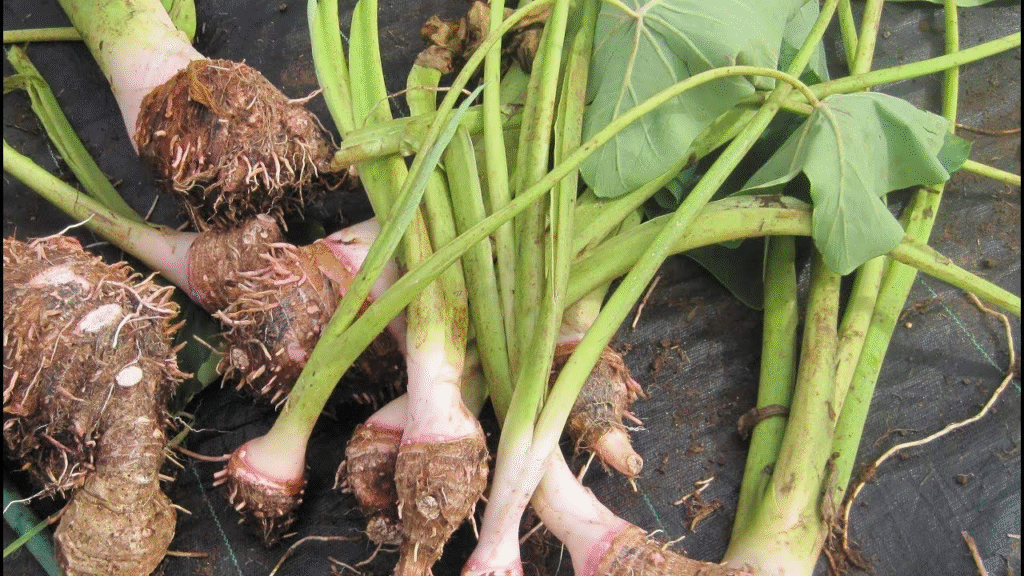
Growth Stages and Timeline
| Growth Stage | Timeline | Care Requirements | Plant Appearance |
|---|---|---|---|
| Planting | Day 0 | Initial watering | Just tubers underground |
| Sprouting | 2-3 weeks | Keep soil moist | First shoots emerging |
| Early growth | 1-2 months | Regular watering, first fertilization | Small leaves developing |
| Vegetative growth | 3-5 months | Consistent moisture, monthly fertilization | Large elephant-ear leaves |
| Maturity | 6-9 months | Reduced watering as leaves yellow | Foliage begins yellowing |
| Harvest time | 7-10 months | Stop watering 1-2 weeks before harvest | Foliage dies back |
Harvesting Process
You’ll know it’s harvest time when:
- The foliage begins to yellow and die back.
- The growing season has lasted 7-10 months (or after first frost in colder regions).
To harvest eddoe:
- Loosen soil around the plant with a garden fork, working carefully to avoid damaging tubers.
- Gently lift the clump of tubers from the soil.
- Brush off excess soil, but don’t wash tubers if you plan to store them.
- Allow harvested tubers to cure in a warm, dry place for 1-2 days.
Common Pests and Diseases
Pest Management
- Aphids: Treat with insecticidal soap or a strong spray of water.
- Spider Mites: Increase humidity and treat with neem oil.
- Root Knot Nematodes: Practice crop rotation and solarize soil before planting.
Disease Prevention
- Root Rot: Ensure proper drainage and avoid overwatering.
- Leaf Blight: Maintain good air circulation and avoid overhead watering.
- Virus Diseases: Start with certified disease-free planting material when possible.
According to the USDA Agricultural Research Service, practicing good sanitation and crop rotation can significantly reduce disease pressure in root crops like eddoe.
Storing and Using Your Eddoe Harvest
Storage Methods
- Short-term: Store unwashed tubers in a cool, dark place (50-60°F/10-15°C) for up to 2 weeks.
- Medium-term: Store in sawdust or sand in a root cellar at 45-55°F (7-13°C) for 1-2 months.
- Long-term: Clean, peel, blanch, and freeze cubed eddoe for up to 6 months.
Culinary Uses
Your homegrown eddoe can be prepared in numerous ways:
- Boiled: Similar to potatoes, excellent for mashing or in stews
- Roasted: Brings out nutty flavors and creates crispy textures
- Fried: Makes excellent chips or fritters
- Steamed: Preserves nutrients and delicate flavor
- Added to soups/stews: Thickens while adding nutrition
Note: Always cook eddoe thoroughly, as raw tubers contain calcium oxalate crystals that can cause irritation.
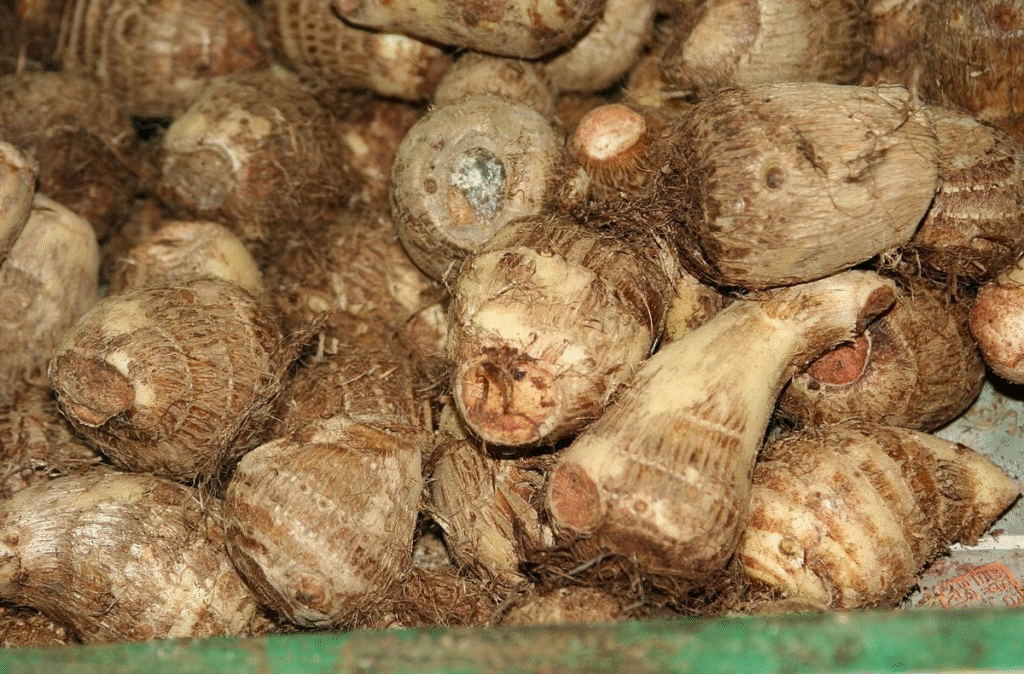
Sustainability and Benefits of Growing Your Own Eddoe
Growing your own eddoe offers several advantages:
- Reduced Carbon Footprint: Eliminates transportation emissions associated with imported eddoe
- No Chemical Concerns: You control what goes into your growing process
- Preservation of Variety: Contributing to agricultural diversity
- Economic Savings: Specialty produce like eddoe commands premium prices in stores
The USDA National Agricultural Library recognizes home gardening of diverse crops as an important component of sustainable food systems and food security.
Conclusion
Growing eddoe at home—whether in your garden, in containers, or indoors—requires some attention to detail but rewards you with a unique, nutritious harvest that’s difficult to find in many US supermarkets. By following the guidance in this article, you’re well on your way to enjoying this versatile root vegetable from your own homegrown supply.
Remember that eddoe’s long growing season means patience is key, but the distinctive flavor and nutritional benefits make it worth the wait. As this tropical tuber continues gaining popularity in the US market, your knowledge of growing it puts you ahead of the curve in sustainable home gardening.
